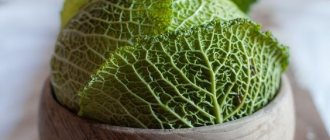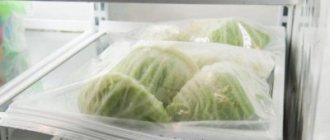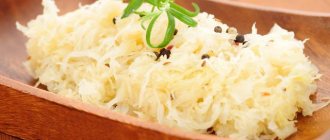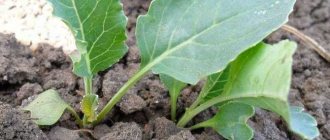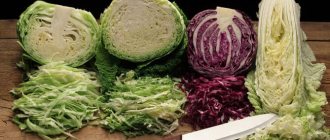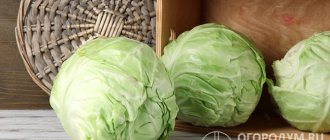Portal about vegetables: recipes, varieties, storage, cultivation
Many housewives purchase vegetables and fruits in advance, freeze them in the freezer, and only then begin to prepare dishes from them.
Freezing is a fairly convenient and simple way to preserve maximum beneficial properties in foods. White cabbage is rich in vitamins, minerals and components important for human health. A large number of delicious dishes are prepared from it. Moreover, the whole family, including very young children, can use them. If you buy cabbage in the summer or spring and freeze it, you can save money, since the vegetable costs much less during the season.
Freezing rules
Having decided to resort to the method, you should know how to properly freeze a vegetable in order to preserve its beneficial qualities and appearance as much as possible.
Preparing to Freeze
To get a good frozen semi-finished product, you should start by choosing high-quality starting material and follow some simple rules:
- To begin with, you should select the most suitable heads of cabbage: without external damage, round, slightly elongated or flattened in shape, with a dense structure.
- Inspect for signs of rotting and the presence of insects (their traces of vital activity).
- Remove outer leaves.
- Rinse the heads of cabbage with tap water.
- Wipe thoroughly with a thick soft cloth and let dry.
Temperature
The correct storage temperature for frozen cabbage in any form is down to –18°C. This is the typical temperature in the freezer compartments of modern domestic refrigerators. If there are three drawers in the freezer, the bottom two are suitable for freezing. At a temperature of 0...–8°C, the semi-finished product is stored for no more than 90 days.
Shelf life
If the vegetable is frozen in accordance with the technology, and you initially selected high-quality raw materials, it can be stored for up to 300 days. That is, if you put the product in the freezer in October, you need to use it before mid-summer.
Important! The re-thawed semi-finished product is not subjected to freezing. In this case, you will get an ice mass devoid of beneficial qualities.
And by this time, early cabbage is already appearing, so if you have enough freezer space, you can stock up on semi-finished products for the whole season.
Is it possible to freeze white cabbage in the freezer?
To make cabbage dishes possible in winter, it should be frozen. But is it possible to do this?
You can freeze this vegetable, but you need to keep in mind that it will no longer be as crispy and tasty. In the freezer, the main properties of the product will still remain, but such cabbage is not suitable for all dishes.
To prepare the salad, it is better to buy fresh cabbage at the supermarket or market. For preparing some dishes, for example, cabbage rolls, cabbage soup, etc., the frozen version is also suitable.
Can Japanese cabbage be frozen?
She doesn’t mind even short-term frosts down to -5ºС. But in terms of productivity, Japanese cabbage has no equal. From one plant per season you can get up to 10 kilograms of juicy greens. And this with minimal care.
Interesting materials:
Who invented kombucha? How long should you cook wild mushrooms for frying? How to cook and fry chanterelle mushrooms? How to cook chanterelle mushrooms? How to identify a false white mushroom? Milk mushroom what is it? What is milk mushroom? Is it possible to eat fly mushroom? Is it possible to eat the tinder fungus? Is it possible to eat Veselka mushroom?
Freezing white cabbage: basic rules
To make cabbage dishes tasty and healthy, you need to follow the basic rules for freezing it. Namely, consider the following useful tips and recommendations:
- You should buy only fresh and young heads of cabbage;
- If there are spoiled leaves on the cabbage, they need to be removed. The leaves should be uniform and fresh;
- You should check if the cabbage is rotting. If the answer is yes, then it is not suitable for freezing;
- Before freezing, you need to wash the vegetable well and then let it dry;
- you also need to check if there are any harmful insects on the cabbage. It's better to do this before purchasing.
These simple rules will help you approach the freezing process correctly.
Before freezing, you may need to separate the cabbage into sheets. It can also be shredded. The freezing method will depend on what dish you plan to prepare next.
You also need to remember that you can only freeze cabbage once. This should not be done again. It should be stored in the freezer for no longer than one year. It's better to use it earlier.
The temperature in the freezer should be up to -19 degrees. You can freeze cabbage either on its own or with other vegetables.
The freezing process itself is quite simple. Washed and dried cabbage should be placed in bags or special containers and placed in the freezer. Care should be taken to ensure that foreign odors do not transfer to the cabbage. To do this, you can use plastic containers with special fasteners.
Are cabbage seedlings afraid of frost? Cabbage and frost
In various regions, the period of possible cooling may last until mid-June.
Whether cabbage seedlings are afraid of frost, what kind of frost cabbage can withstand in the spring, and how low temperatures can affect the quality of the crop depends on what type and variety was chosen for cultivation.
Temperature limits for use
Plant seedlings with the seedless growing method die at -3°C. If the seedlings were grown in cold greenhouses or were pre-hardened before planting in the garden, then they can withstand a short-term decrease in temperature to -5°C, but in this case the total weight and quality of the finished heads of cabbage decreases. If the temperature outside drops below -5°C, the seedlings die.
Reasons for freezing cabbage
Let's consider the reasons for the death of cabbage during frosts. Both frost and heat are harmful to the development and life of cabbage seedlings in spring.
If the air temperature drops below 0°C, the water in the plant cells freezes and turns into ice. From the physics course we know that if water is frozen, then when it freezes it increases in volume. The same thing happens in plants. When frozen, the liquid ruptures the seedling cells from the inside, and the cabbage dies. Sudden thawing after sunrise is especially dangerous for plants.
You can't let it thaw
The influence of low temperature can aggravate the wrong choice of planting site, as well as the condition of the seedlings.
Risk areas for cabbage
Do not plant plants on heavy soils or in lowlands. Light loamy areas well protected from the wind are suitable for it. In addition to the fact that there is constant stagnation of moisture in the lowlands, the air during frosts is also 2-3°C lower than in the flat areas.
For optimal plant development, the soil should not be acidic. On such soils, cabbage will not be able to develop normally, it will get sick, and the fertilizers that you apply will not be able to be completely absorbed by the seedlings. Therefore, if the soil on the site is acidic, then it needs to be limed. Dolomite flour is perfect for these purposes, as it will additionally enrich the earth with potassium. If flour is not available, you can use chalk, ash or lime. Only lime can be used exclusively during autumn digging, so as not to damage the seedlings.
If the acidity level is increased, then the soil is treated with lime
Whether cabbage is afraid of spring frosts, and how affected the seedlings will be, also depends on the general condition of the plants. If they are healthy, have managed to strengthen and grow well, then the seedlings will recover from stress much faster and the damage to the crop will be minimal.
To grow healthy seedlings, you need to maintain temperature conditions. The optimal range is 12-20°C. Higher temperatures lead to seedlings beginning to lag behind in development, becoming weak and not as viable.
It is also necessary to monitor the water regime. Cabbage is a moisture-loving plant, but watering should be such that there is no stagnation of water in the holes. Excess water, as well as its lack, can lead to disease or death of plants.
Note! The tolerance of low temperatures by seedlings also depends on the type of cabbage.
Simple dishes from frozen white cabbage
You can use cabbage to prepare solyanka, borscht, cabbage soup and many other dishes. Today you can find a large number of them in cookbooks and on the Internet. You can experiment and create completely new masterpieces. Let's look at a few simple recipes for frozen white cabbage.
Cabbage Pie
To make this dish you will need the following ingredients:
- 550 grams of cabbage;
- 6 tablespoons of sour cream;
- 3 eggs;
- 6 and a half tablespoons of flour;
- 3 tablespoons of mayonnaise (it is better to use homemade);
- 2 teaspoons baking powder;
- dill;
- salt to taste.
Thaw cabbage, chop and mix with herbs. Add salt. Beat the eggs with a mixer and add all the remaining ingredients to them. Next, you need to knead the dough and place it on a baking sheet or in a mold.
To prevent the dough from sticking, you need to grease the mold with vegetable oil. The dough is placed in the oven and baked for half an hour until done. The result will be a delicious pie.
This dish will appeal to all lovers of culinary experiments. Many people are probably used to cabbage rolls. But not everyone knows about lazy cabbage rolls. To prepare this simple dish you need to take:
- cabbage 500 grams;
- 1/3 cup rice;
- 1 carrot;
- half an onion;
- 300 grams of minced meat;
- 200 grams of tomatoes;
- greenery;
- spices;
- 1.5 tablespoons of sour cream.
First, take the cabbage out of the freezer and fry it in vegetable oil with chopped onions and grated carrots.
The rice must be boiled and mixed with the minced meat. At this time, the tomatoes should be cut and mixed well. They also need to be salted and other spices added as desired. This will be the sauce.
Minced meat and cabbage are laid out in layers in the mold. Pour the sauce over the casserole and place in the oven for about 50 minutes (check the readiness periodically). The temperature should be 200-220 degrees.
There is no need to use foil to prepare this dish.
Pies with cabbage
- 4 chicken eggs;
- 150 grams of mushrooms;
- 1 glass of kefir;
- 1 onion;
- 1/3 fork cabbage;
- 1/3 cup sugar;
- vegetable oil;
- a little flour (to form a dough);
- half a teaspoon of soda;
- half a teaspoon of salt.
- Chop the onion, cabbage and mushrooms and fry in a frying pan with vegetable oil.
- Add eggs and salt. Mix everything well.
- Beat eggs with sugar. Add flour and other ingredients to form a dough.
- Sprinkle a little flour on the board. Place the dough. Roll it out and cut out balls.
- Make pies and put cabbage filling inside.
- Fry the pies on both sides in a frying pan until golden brown.
Probably everyone knows how to cook borscht. For beginners, you can offer a delicious and simple recipe for this dish.
- 1 carrot;
- 1 beet;
- small cabbage;
- 1 onion;
- 5 pieces of potatoes;
- vegetable oil;
- tomato paste;
- salt, pepper and other seasonings as desired.
First you need to wash the carrots and potatoes. Clean them. The cabbage should be thawed and grated or chopped.
Pour water into a bowl, add salt and diced potatoes. Cook the potatoes until done.
Peel and finely chop the onion. Fry it in vegetable oil with grated beets and carrots. The resulting mixture should be simmered in a frying pan for several minutes with the lid closed. You also need to add cabbage and tomato paste here. Mix everything and simmer until done.
Place the finished mixture in a saucepan with water and boiled potatoes. If desired, you can add seasonings here and mix everything.
In a few minutes the borscht will be ready. Bon appetit.
Before you start preparing dishes with frozen cabbage, it is better to play it safe and find out how it is defrosted. This is done in several ways Read more…
- home
- Catalog
- Best selections
- Vegetables
- Cabbage
- Frozen cabbage
In what container should I store it?
The forks are completely wrapped in cling film. It is convenient to freeze fresh and stewed cabbage in zip bags and containers. You can use any cookware except aluminum. It is not recommended for all types of workpieces. Don’t forget to put stickers on the container with the name and expiration date. This will make it easier for you to keep track of the relevance of your inventory.
It’s convenient to freeze stewed cabbage for pies in large portions, and heads of cabbage are good for cabbage rolls because the leaves will become soft and you won’t have to scald them with boiling water and beat them with a hammer. Chopped or shredded cabbage is suitable for borscht or cabbage soup. It is not defrosted, but thrown into the broth directly from the chamber.
This preparation is easy to make. It will not only save your time, but also preserve vitamins for the winter. If you think you can’t handle freezing, watch the video recipe and you will understand that everything is simple.
Did you like the recipe? Save it to yourself on Pinterest, FB, VK, OK, G+, Instagram so as not to lose it!
Autumn is the peak season for harvesting various vegetables collected during the season. If the year turns out to be rich in cabbage harvest, the question arises - how to keep it fresh for a long time. In most cases, cabbage is stored in a cellar or basement. If they are absent, but if you have a large and capacious freezer, the vegetable can be frozen.
Freezing cabbage:
How to Defrost and Cook Frozen Cabbage
It is enough to keep frozen broccoli at room temperature for about an hour. But only if you are planning to make baked goods or add them to a salad. There is almost no liquid in it, which greatly simplifies the cooking process. You can safely add broccoli to soups, casseroles, stews and any main courses (especially those with sauce).
Most often, frozen cabbage is found in recipes with these five products:
| Product | Number of recipes with combination | Calories kcal per 100g | Proteins g per 100g | Fats g per 100g | Carbohydrates g per 100g |
| Bulb onions | 2 | 41 | 1.4 | 10.4 | |
| Carrot | 2 | 33 | 1.3 | 0.1 | 6.9 |
| Flour | 2 | 325 | 12 | 1 | 67 |
| Eggs | 2 | 157 | 12.7 | 10.9 | 0.7 |
| Greenery | 2 | 41 | 3.7 | 0.4 | 7 |
The same can be said about any other variety of cabbage similar to this one: cauliflower, Brussels sprouts, broccolini.
Frozen cabbage is prepared less frequently than all others. Mainly because in Russia it is available all year round. And in cellars it is stored whole forks no worse than planed in the refrigerator. However, many people prefer to freeze this cabbage into sheets for cabbage rolls.
It also needs to be defrosted at room temperature. The sheets can be thrown into the microwave - when hot they are lighter and easier to roll into a roll. It is better to cook only soups and hot dishes from frozen cabbage. It won’t go into salads – the texture and taste will be very different. Also, be extremely careful when exposing it to high temperatures. If you overdo it, the cabbage will turn into mush.
Each individual recipe with frozen cabbage will usually specify how it should be processed or prepared—just follow the instructions.
White cabbage can be frozen, but once defrosted, it may not be used in all recipes. Frozen cabbage is only suitable for preparing hot dishes - borscht, cabbage rolls, cabbage rolls or for filling pies. You can't put it in a salad. After freezing, the vegetable will become soft and non-crisp.
If you're very cold
Staged resuscitation
You can try to bring completely frozen cabbage back to life.
To do this, it is placed for two or three days in a room with a temperature of about +4 degrees, after which it is transferred to a warmer room (up to +15 degrees), covered and kept there until complete recovery. Although it is not guaranteed even after performing the procedure.
Dense cabbage heads tolerate frost worse than loose cabbage heads. The presence of air spaces between the leaves creates additional protection against the penetration of cold into the core of the fruit.
What is frozen cabbage good for?
If there is no need to store frozen cabbage, then it should be brought into a cool room (from +5 to +10 degrees) and allowed to thaw, after which, in most cases, it is suitable for pickling, pickling (see recipe here), pickling or direct use in cooking.
Cabbage fermented from frozen heads of cabbage is best used not as an independent dish, but for preparing first courses, and also subjected to heat treatment.
It should be remembered that frozen cabbage requires less time to cook, since it is initially softer.



